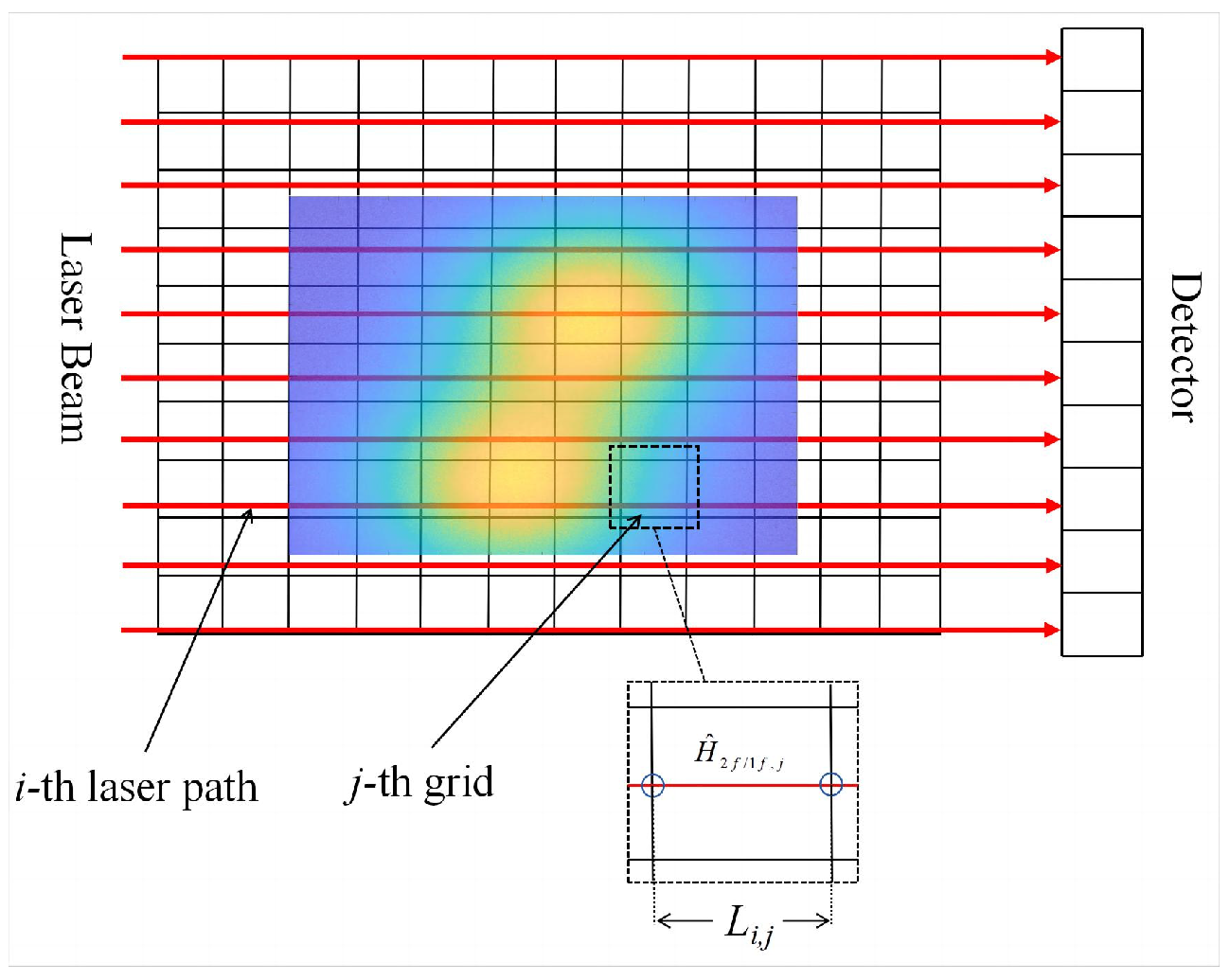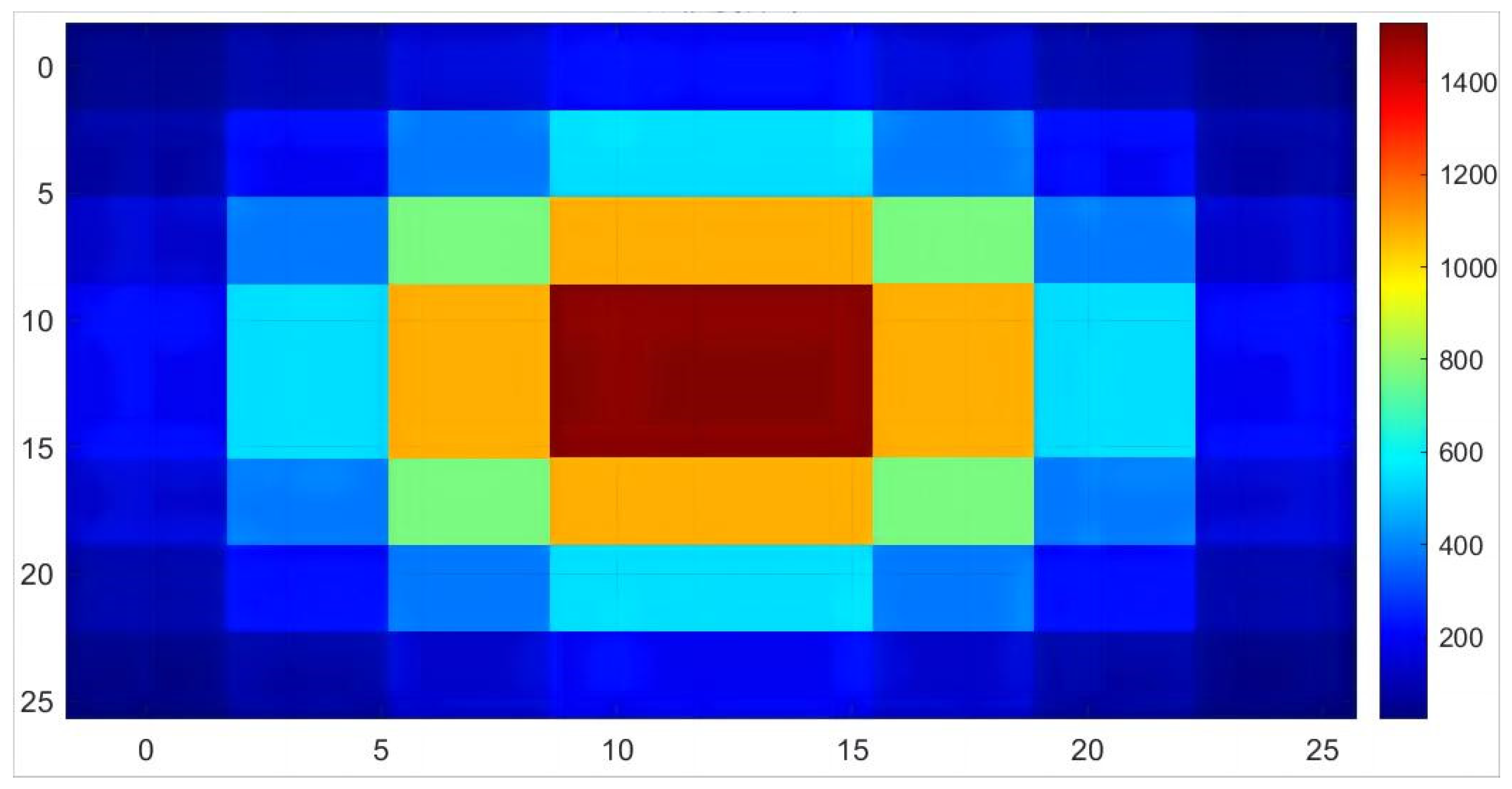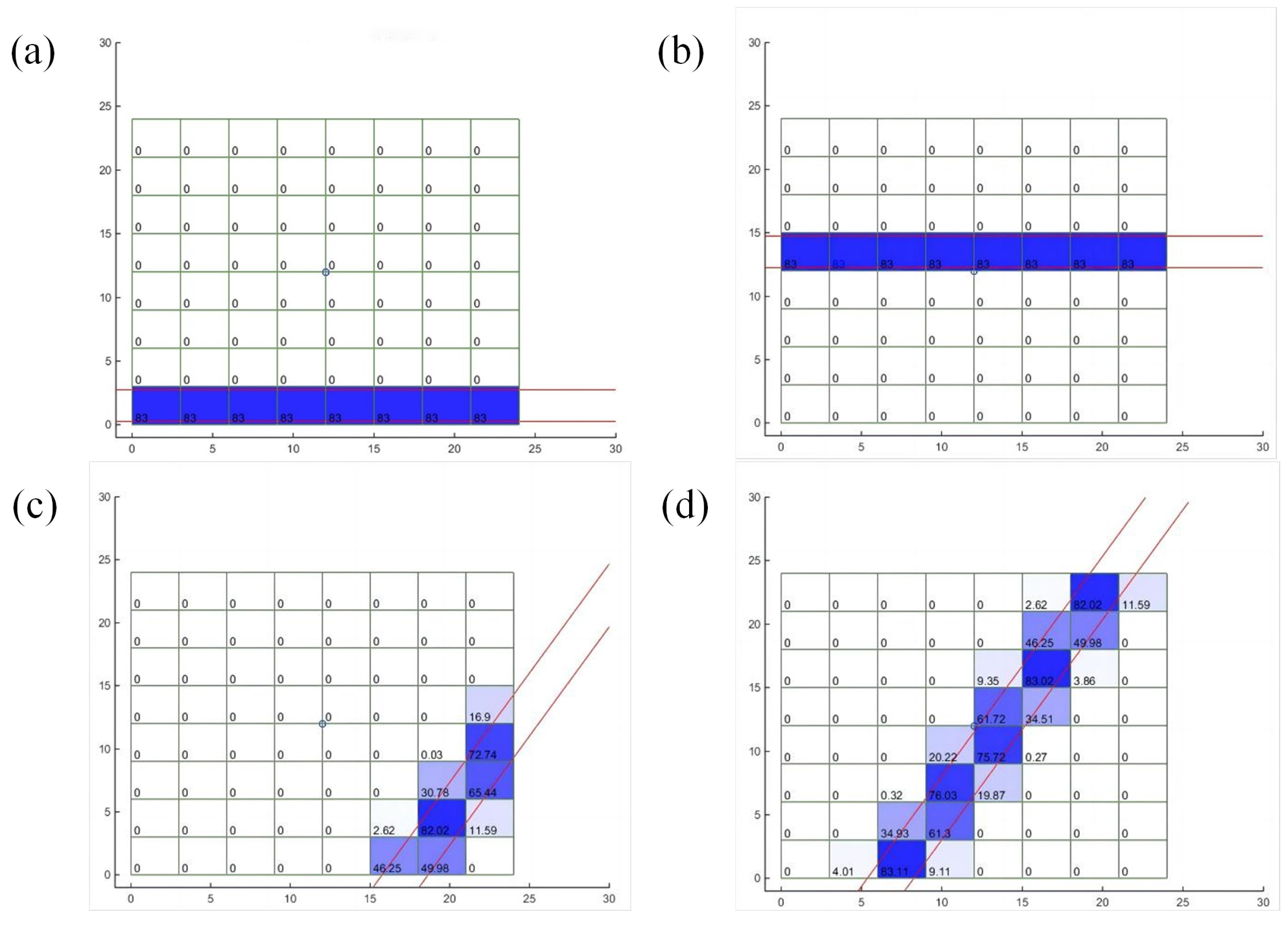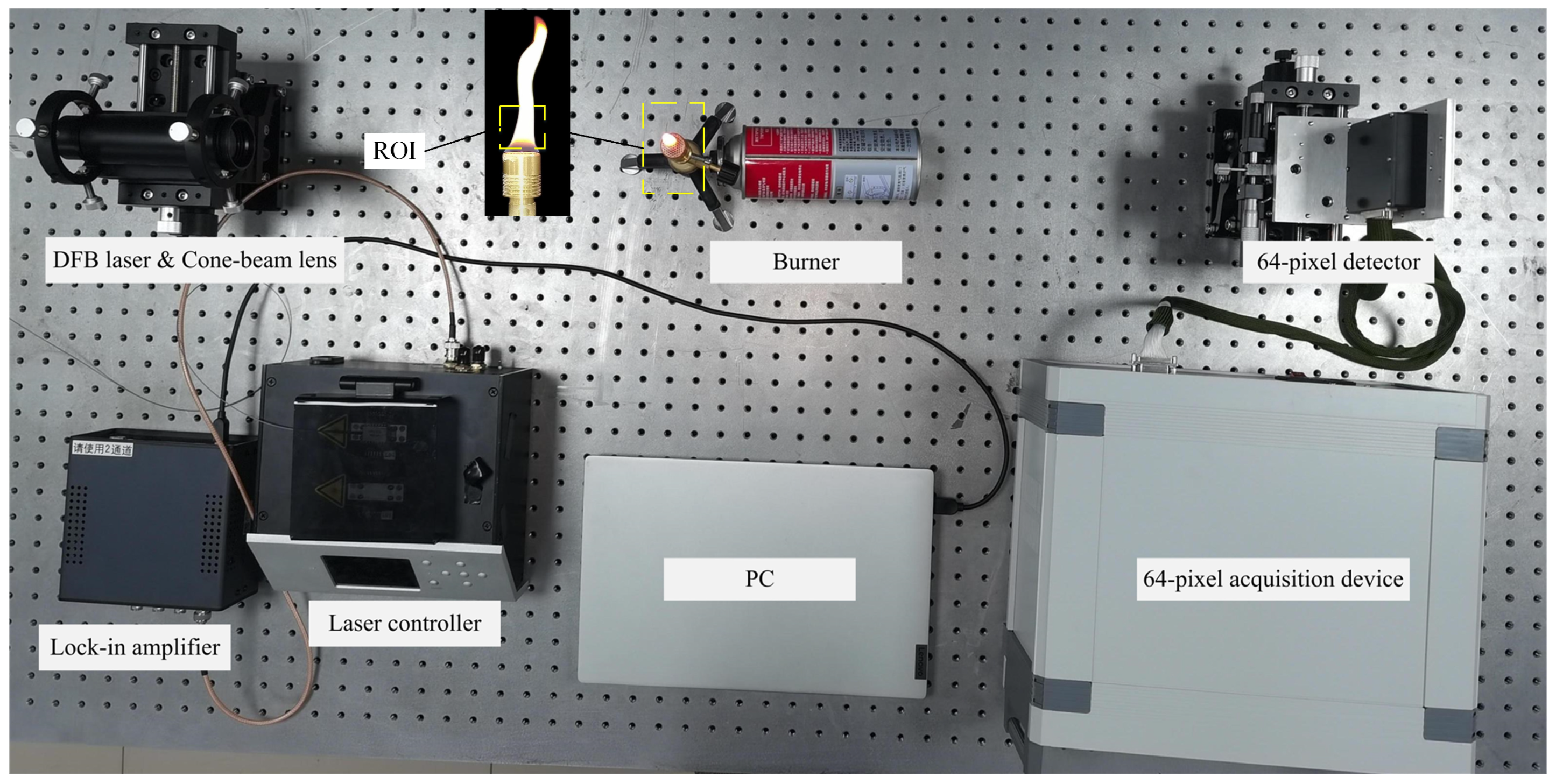Flame Imaging Technology Based on 64-Pixel Area Array Sensor
Abstract
:1. Introduction
2. Materials and Methods
2.1. Tunable Diode Laser Absorption Spectroscopy
2.2. ART Theory
- (1)
- Discretely divide the area to be reconstructed into a grid with a specific resolution. Usually, the resolution of this grid is higher than the resolution of the detector;
- (2)
- Combine the projection equations corresponding to the projection rays for each pixel of the detector to form a linear equation system, where each equation contains the object attenuation coefficient;
- (3)
- Assign an initial value to the projection weight of the discrete grid obtained in step (1), and calculate the projection coefficient of each projection ray based on this;
- (4)
- Starting from the first projection equation, solve the calculated projection value and obtain the difference with the real projection value. According to the iterative formula, gradually correct the discrete grid projection weight;
- (5)
- Use the corrected projection weight value to be brought into the second projection equation, and perform similar operations in (4) until the last ray to complete an iteration;
- (6)
- Repeat steps (4) and (5), except that the latest projection weight coefficient is used starting from the first equation for the second iteration until, after several iterations, the two adjacent grid projections are the difference in weight values, which will already be very small. The calculation ends, and the solution to the linear equations is finally obtained.
3. Simulation Analysis
3.1. Numerical Simulation
3.2. Analysis of the Influence of Physical Quantities
4. Experiment
5. Conclusions
Author Contributions
Funding
Data Availability Statement
Conflicts of Interest
References
- Krishnamoorthi, M.; Malayalamurthi, R.; He, Z.; Kandasamy, S. A review on low temperature combustion engines: Performance, combustion and emission characteristics. Renew. Sustain. Energy Rev. 2019, 116, 109404. [Google Scholar] [CrossRef]
- Gao, Y.; Liu, Y.; Dong, Z.; Ma, D.; Yang, B.; Qiu, C. Preliminary experimental study on combustion characteristics in a solid rocket motor nozzle based on the TDLAS system. Energy 2023, 268, 126741. [Google Scholar] [CrossRef]
- Ji, Z.; Duan, F.L.; Xie, Z. Transient measurement of temperature distribution using thin film thermocouple array on turbine blade surface. IEEE Sens. J. 2020, 21, 207–212. [Google Scholar] [CrossRef]
- Chen, S.; Hao, X.; Pan, B.; Huang, X. Super-resolution residual U-Net model for the reconstruction of limited-data tunable diode la-ser absorption tomography. ACS Omega 2022, 7, 18722–18731. [Google Scholar] [CrossRef] [PubMed]
- Xiong, C.; Liu, Y.; Fan, H.; Huang, X.; Nakamura, Y. Fluctuation and extinction of laminar diffusion flame induced by external acoustic wave and source. Sci. Rep. 2021, 11, 14402. [Google Scholar] [CrossRef]
- Wang, S.; Zhang, D.; Wang, W.; Zhong, J.; Feng, K.; Wu, Z.; Du, B.; He, J.; Li, Z.; He, L.; et al. Grave-to-cradle upcycling of Ni from electroplating wastewater to photothermal CO2 ca-talysis. Nat. Commun. 2022, 13, 5305. [Google Scholar] [CrossRef]
- Chen, T.; Guo, X.; Jia, J.; Xiao, J. Frequency and phase characteristics of candle flame oscillation. Sci. Rep. 2019, 9, 342. [Google Scholar] [CrossRef]
- Aouali, A.; Chevalier, S.; Sommier, A.; Abisset-Chavanne, E.; Batsale, J.-C.; Pradere, C. 3D infrared thermospectroscopic imaging. Sci. Rep. 2020, 10, 22310. [Google Scholar] [CrossRef]
- Hansen, N.; Tranter, R.S.; Moshammer, K.; Randazzo, J.B.; Lockhart, J.P.; Fugazzi, P.G.; Tao, T.; Kastengren, A.L. 2D-imaging of sampling-probe perturbations in laminar premixed flames using Kr X-ray fluorescence. Combust. Flame 2017, 181, 214–224. [Google Scholar] [CrossRef]
- Wang, J.; Hao, X.; Pan, B.; Huang, X.; Sun, H.; Pei, P. Spectroscopic measurement of the two-dimensional flame temperature based on a perovskite single photodetector. Opt. Express 2023, 31, 8098–8109. [Google Scholar] [CrossRef]
- Wang, J.; Hao, X.; Pan, B.; Huang, X.; Sun, H.; Pei, P. Perovskite single-detector visible-light spectrometer. Opt. Lett. 2023, 48, 399–402. [Google Scholar] [CrossRef] [PubMed]
- Pei, P.; Du, H.; Hao, X. Research on the Dynamic Model of Fireball Thermal Dose Based on the Effective Band Integral Method. ACS Omega 2023, 8, 29717–29724. [Google Scholar] [CrossRef] [PubMed]
- Wu, J.; Chen, H.; Kang, G.; Li, X. TDLAS second harmonic demodulation based on Hilbert transform. PLoS ONE 2022, 17, e0278724. [Google Scholar] [CrossRef] [PubMed]
- Chang, J.; He, Q.; Li, J.; Feng, Q. Oxygen detection system based on TDLAS–WMS and a compact multipass gas cell. Microw. Opt. Technol. Lett. 2023, 65, 1141–1145. [Google Scholar] [CrossRef]
- Huang, A.; Xu, Z.; Deng, H.; Yang, W.; Qi, X.; Li, J.; Kan, R. High-pressure gas temperature sensing for exit plane of aero-engine combustor using tunable diode laser absorption spectroscopy. Microw. Opt. Technol. Lett. 2023. [Google Scholar] [CrossRef]
- Wang, Z.; Deguchi, Y.; Kamimoto, T.; Tainaka, K.; Tanno, K. Pulverized coal combustion application of laser-based temperature sensing system using computed tomography–tunable diode laser absorption spectroscopy (CT-TDLAS). Fuel 2020, 268, 117370. [Google Scholar] [CrossRef]
- Kumar, A.; Rana, A.S. H-Theorem and Boundary Conditions for Two-Temperature Model: Application to Wave Propagation and Heat Transfer in Polyatomic Gases. arXiv 2023, arXiv:2309.01459. [Google Scholar] [CrossRef]
- Otero, R.; Lowe, K.T.; Ng, W.F. Non-intrusive acoustic measurement of flow velocity and temperature in a high subsonic Mach number jet. Meas. Sci. Technol. 2017, 29, 015106. [Google Scholar] [CrossRef]
- Si, J.; Fu, G.; Cheng, Y.; Zhang, R.; Enemali, G.; Liu, C. A quality-hierarchical temperature imaging network for TDLAS tomography. IEEE Trans. Instrum. Meas. 2022, 71, 4500710. [Google Scholar] [CrossRef]
- Liu, C.; Xu, L. Laser absorption spectroscopy for combustion diagnosis in reactive flows: A review. Appl. Spectrosc. Rev. 2019, 54, 1–44. [Google Scholar] [CrossRef]
- Goldenstein, C.S.; Spearrin, R.M.; Jeffries, J.B.; Hanson, R.K. Infrared laser-absorption sensing for combustion gases. Prog. Energy Combust. Sci. 2017, 60, 132–176. [Google Scholar] [CrossRef]
- Qiu, S.; Cao, Z.; Zhang, X.; Xu, L. Single Spectral Line Method for TDLAS Imaging of Temperature and Water Vapor Concentration. IEEE Trans. Instrum. Meas. 2023, 72, 9503611. [Google Scholar] [CrossRef]
- Kamimoto, T.; Deguchi, Y.; Zhang, N.; Nakao, R.; Takagi, T.; Zhang, J.-Z. Real-time 2D concentration measurement of CH4 in oscillating flames using CT tunable diode laser absorption spectroscopy. J. Appl. Nonlinear Dyn. 2015, 4, 295–303. [Google Scholar] [CrossRef]
- Kamimoto, T.; Deguchi, Y.; Kiyota, Y. High temperature field application of two-dimensional temperature measurement technology using CT tunable diode laser absorption spectroscopy. Flow Meas. Instrum. 2015, 46, 51–57. [Google Scholar] [CrossRef]
- Xia, H.; Xu, Z.; Kan, R.; He, Y.; Liu, J.; Zhang, G. Numerical study of two-dimensional water vapor concentration and temperature distribution of combustion zones using tunable diode laser absorption tomography. Infrared Phys. Technol. 2015, 72, 170–178. [Google Scholar] [CrossRef]
- Xia, H.; Kan, R.; Xu, Z.; He, Y.; Liu, J.; Chen, B.; Yang, C.; Yao, L.; Wei, M.; Zhang, G. Two-step tomographic reconstructions of temperature and species concentration in a flame based on laser absorption measurements with a rotation platform. Opt. Lasers Eng. 2017, 90, 10–18. [Google Scholar] [CrossRef]
- Qiu, S.; Cao, Z.; Wen, J.; Zhang, X.; Xu, L. A binary valued reconstruction algorithm for discrete TDLAS tomography of dynamic flames. IEEE Trans. Instrum. Meas. 2023, 72, 9506614. [Google Scholar] [CrossRef]
- Li, M.; Xu, L.; Cao, Z. TDLAS tomography system for online imaging and dynamic process playback of temperature and gas mole fraction. IEEE Trans. Instrum. Meas. 2022, 71, 2006210. [Google Scholar] [CrossRef]
- Huang, A.; Cao, Z.; Zhao, W.; Zhang, H.; Xu, L. Frequency-division multiplexing and main peak scanning WMS method for TDLAS tomography in flame monitoring. IEEE Trans. Instrum. Meas. 2020, 69, 9087–9096. [Google Scholar] [CrossRef]
- Gordon, I.E.; Rothman, L.S.; Hargreaves, R.J.; Hashemi, R.; Karlovets, E.; Skinner, F.; Conway, E.; Hill, C.; Kochanov, R.; Tan, Y.; et al. The HITRAN2020 molecular spectroscopic database. J. Quant. Spectrosc. Radiat. Transf. 2022, 277, 107949. [Google Scholar] [CrossRef]
- Jeon, M.G.; Hong, J.W.; Doh, D.H.; Deguchi, Y. A study on two-dimensional temperature and concentration distribution of Propane-Air premixed flame using CT-TDLAS. Mod. Phys. Lett. B 2020, 34, 2040020. [Google Scholar] [CrossRef]
- Zhao, W.; Xu, L.; Huang, A.; Gao, X.; Luo, X.; Zhang, H.; Chang, H.; Cao, Z. A WMS based TDLAS tomographic system for distribution retrievals of both gas concentration and temperature in dynamic flames. IEEE Sens. J. 2019, 20, 4179–4188. [Google Scholar] [CrossRef]
- Jeon, M.G.; Deguchi, Y.; Kamimoto, T.; Doh, D.-H.; Cho, G.-R. Performances of new reconstruction algorithms for CT-TDLAS (computer tomography-tunable diode laser absorption spectroscopy). Appl. Therm. Eng. 2017, 115, 1148–1160. [Google Scholar] [CrossRef]
- Choi, D.W.; Jeon, M.G.; Cho, G.R.; Kamimoto, T.; Deguchi, Y.; Doh, D.-H. Performance improvements in temperature reconstructions of 2-D tunable diode laser absorption spectroscopy (TDLAS). J. Therm. Sci. 2016, 25, 84–89. [Google Scholar] [CrossRef]
- Peng, D.; Jin, Y.; Zhai, C. Research on reconstruction algorithms for 2D temperature field based on TDLAS. In Proceedings of the AOPC 2015: Optical and Optoelectronic Sensing and Imaging Technology, Beijing, China, 5–7 May 2015; SPIE: Bellingham, WA, USA, 2015; Volume 9674, pp. 249–259. [Google Scholar]







| Position | Thermocouple Measurements (K) | Reconstructed Value (K) | Relative Error (%) |
|---|---|---|---|
| 1 | 619 | 642 | 3.71 |
| 2 | 1095 | 1128 | 3.01 |
| 3 | 637 | 658 | 3.29 |
Disclaimer/Publisher’s Note: The statements, opinions and data contained in all publications are solely those of the individual author(s) and contributor(s) and not of MDPI and/or the editor(s). MDPI and/or the editor(s) disclaim responsibility for any injury to people or property resulting from any ideas, methods, instructions or products referred to in the content. |
© 2023 by the authors. Licensee MDPI, Basel, Switzerland. This article is an open access article distributed under the terms and conditions of the Creative Commons Attribution (CC BY) license (https://creativecommons.org/licenses/by/4.0/).
Share and Cite
Huang, X.; Hao, X.; Pan, B.; Liang, X.; Wang, Z.; Feng, S.; Pei, P.; Zhang, H. Flame Imaging Technology Based on 64-Pixel Area Array Sensor. Micromachines 2024, 15, 44. https://doi.org/10.3390/mi15010044
Huang X, Hao X, Pan B, Liang X, Wang Z, Feng S, Pei P, Zhang H. Flame Imaging Technology Based on 64-Pixel Area Array Sensor. Micromachines. 2024; 15(1):44. https://doi.org/10.3390/mi15010044
Chicago/Turabian StyleHuang, Xiaodong, Xiaojian Hao, Baowu Pan, Xiaodong Liang, Zheng Wang, Shenxiang Feng, Pan Pei, and Heng Zhang. 2024. "Flame Imaging Technology Based on 64-Pixel Area Array Sensor" Micromachines 15, no. 1: 44. https://doi.org/10.3390/mi15010044





